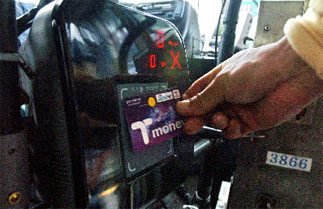What do the smart cards in cell phones do?

But what exactly is a USIM? How does it make this possible?
It used to be the case that customers’ phones were locked into a certain cell phone provider.
But the Korea Communications Commission decided in March to lift the USIM lock for third-generation cell phones, allowing consumers to continue using their old handsets even with another mobile company.
A USIM is a form of mobile identification.
Short for Universal Subscriber Identity Module, this small memory chip is a smart card that contains user information.
A smart card is a pocket-sized card with embedded integrated circuits which can process data.
In Korea, USIM chips were adopted when WCDMA, a third-generation mobile communication service, was launched.
WCDMA, which stands for Wideband Code Division Multiple Access, is a new, more sophisticated technology. It allows new services such as video calls and functions that were previously only available on the Internet.
Among the three mobile service carriers, only LG Telecom has not adopted the WCDMA standard for its third-generation service. This is why LG phones do not have USIMs.
Previously, a memory chip that could not be removed was fitted into handsets. This chip contained the user’s information.
Have you noticed how, when you get a new phone, the clerks will type away on the computer for ages and you don’t know what they’re doing?
They are actually going through the process of inputting user information on the handset.
When the user terminates the subscription, the information is deleted and phone calls cannot be made as the phone has become a “nonregistered handset.”
You need to go through the registration process to resume use of the phone.
But with a USIM which contains your user information, all you need to do is put it into a phone. The phone then automatically reads the user information.
This is why customers don’t need to go through the complicated process of computer registration whenever they change mobile service providers.
The USIM unlock is expected to encourage consumers to have more than one handset with a single USIM card. It will also facilitate the trade of secondhand phones.
Consumers will no longer have to take out a new subscription when they want to buy a new phone, even if the phone is not available from their mobile service provider.
In Europe, a similar service was implemented with second-generation mobile phones.
European cell phones had slots in which to put SIM (Subscriber Identity Module) cards.
The first SIM card was made by a smart card manufacturer in Germany in 1991. SIM cards, which are about the same size as a memory card in a digital camera, were popular as people could freely use borrowed cell phones with their own SIM cards.
The problem with the mobile industry in Korea was that the three mobile carriers did not allow their cell phones to read USIM chips from rival companies.
For example, a KTF cell phone would not work with a USIM card that belonged to a handset made for SK Telecom, and vice versa.
Despite complaints from cell phone users, the companies refused to lift the USIM lock, saying that it could be dangerous for customers if their handsets, which contain crucial personal information, were stolen.
But the Korea Communications Commission’s decision in March to unlock USIMs has spurred their use.
The Anycall Minimal, which is manufactured by Samsung Electronics, has been made for SK Telecom but will also work with USIM chips from KTF phones.
A number of such phones, including one by manufacturer SKY, are set for launch by the end of this year.
One of the greatest advantages of USIM chips is that they allow you to change cell phones whenever you want.
This means that you can easily borrow a cell phone whenever you need to.
For example, if the battery on your cell phone has run out but you need to make an urgent phone call, you can borrow a phone from one of your friends and use it with your USIM chip. USIMs also work like a credit card, allowing you access to banking services.
A standard for USIM banking is currently being developed by the local financial sector.
When the standard is finalized, a cell phone user will be able to do Internet banking with up to 10 bank accounts. To use a USIM banking service, the chip will first need to be embedded with a banking function.
The chip would contain Internet banking information allowing the user to perform basic banking transactions, including money transfer and currency exchange.
Users of cell phones with USIM chips will also be able to make stock transactions, monitoring stock prices and placing orders.
But they will need to request the service from securities firms and download the required software.
The chip can also work like a credit card if the user chooses to apply for the service.
This means that users will no longer need to carry around a wallet full of credit cards in order to make financial transactions.
The payment is deducted from the user’s credit card account.
Earlier this year telecom operator KTF and credit card giant Shinhan Card formed a joint venture to launch a mobile phone payment system.
Subscribers to the Mobile Credit are issued with a credit card and a USIM chip. They can pay for purchases at shops and restaurants either with the credit card or with a mobile phone containing the USIM.
By Kim Chang-woo JoongAng Ilbo [spring@joongang.co.kr]










with the Korea JoongAng Daily
To write comments, please log in to one of the accounts.
Standards Board Policy (0/250자)